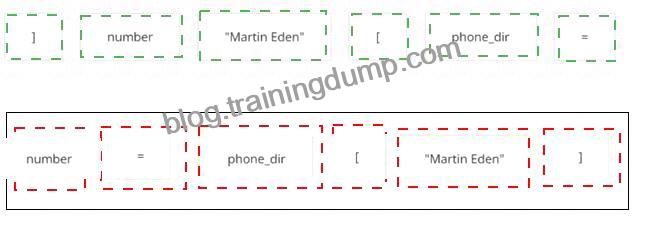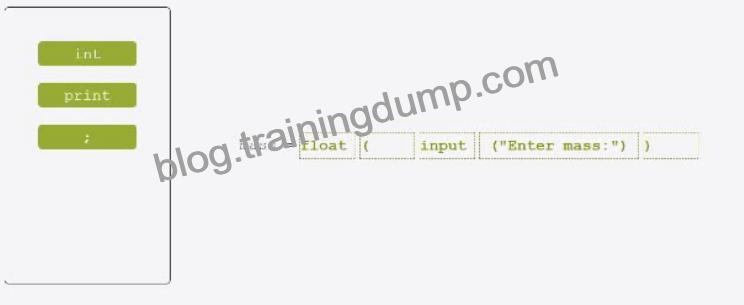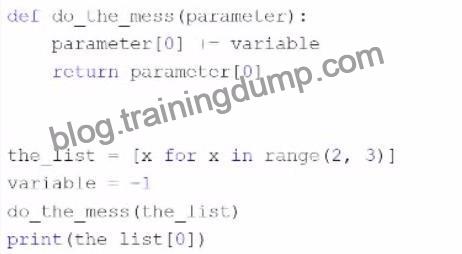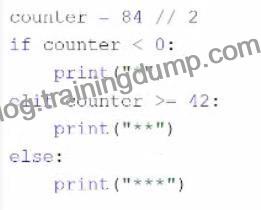NO.13 Assuming that the phonc_dir dictionary contains namemumber pairs, arrange the code boxes to create a valid line of code which retrieves Martin Eden’s phone number, and assigns it to the number variable.


Explanation

number = phone_dir[“Martin Eden”]
This code uses the square brackets notation to access the value associated with the key “Martin Eden” in the phone_dir dictionary. The value is then assigned to the variable number. A dictionary is a data structure that stores key-value pairs, where each key is unique and can be used to retrieve its corresponding value. You can find more information about dictionaries in Python in the following references:
[Python Dictionaries – W3Schools]
[Python Dictionary (With Examples) – Programiz]
[5.5. Dictionaries – How to Think Like a Computer Scientist …]
NO.14 Insert the code boxes in the correct positions in order to build a line of code which asks the user for a float value and assigns it to the mass variable.
(Note: some code boxes will not be used.)


Explanation

One possible way to insert the code boxes in the correct positions in order to build a line of code that asks the user for a float value and assigns it to the mass variable is:
mass = float(input(“Enter the mass:
This line of code uses the input function to prompt the user for a string value, and then uses the float function to convert that string value into a floating-point number. The result is then assigned to the variable mass.
You can find more information about the input and float functions in Python in the following references:
[Python input() Function]
[Python float() Function]
NO.16 What is the expected result of running the following code?

Explanation
The code snippet that you have sent is trying to use the index method to find the position of a value in a list.
The code is as follows:
the_list = [1, 2, 3, 4, 5] print(the_list.index(6))
The code starts with creating a list called “the_list” that contains the numbers 1, 2, 3, 4, and 5. Then, it tries to print the result of calling the index method on the list with the argument 6. The index method is used to return the first occurrence of a value in a list. For example, the_list.index(1) returns 0, because 1 is the first value in the list.
However, the code has a problem. The problem is that the value 6 is not present in the list, so the index method cannot find it. This will cause a ValueError exception, which is an error that occurs when a function or operation receives an argument that has the right type but an inappropriate value. The code does not handle the exception, and therefore it will terminate with an error message.
The expected result of the code is an unhandled exception, because the code tries to find a value that does not exist in the list. Therefore, the correct answer is C. The code raises an unhandled exception.
NO.17 Assuming that the following assignment has been successfully executed:

Which of the following expressions evaluate to True? (Select two expressions.)
Explanation
The code snippet that you have sent is assigning a list of four values to a variable called “the_list”. The code is as follows:
the_list = [‘1’, 1, 1, 1]
The code creates a list object that contains the values ‘1’, 1, 1, and 1, and assigns it to the variable “the_list”.
The list can be accessed by using the variable name or by using the index of the values. The index starts from
0 for the first value and goes up to the length of the list minus one for the last value. The index can also be negative, in which case it counts from the end of the list. For example, the_list[0] returns ‘1’, and the_list[-1] returns 1.
The expressions that you have given are trying to evaluate some conditions on the list and return a boolean value, either True or False. Some of them are valid, and some of them are invalid and will raise an exception.
An exception is an error that occurs when the code cannot be executed properly. The expressions are as follows:
A). the_List.index {“1”} in the_list: This expression is trying to check if the index of the value ‘1’ in the list is also a value in the list. However, this expression is invalid, because it uses curly brackets instead of parentheses to call the index method. The index method is used to return the first occurrence of a value in a list. For example, the_list.index(‘1’) returns 0, because ‘1’ is the first value in the list. However, the_list.index
{“1”} will raise a SyntaxError exception and output nothing.
B). 1.1 in the_list |1:3 |: This expression is trying to check if the value 1.1 is present in a sublist of the list.
However, this expression is invalid, because it uses a vertical bar instead of a colon to specify the start and end index of the sublist. The sublist is obtained by using the slicing operation, which uses square brackets and a colon to get a part of the list. For example, the_list[1:3] returns [1, 1], which is the sublist of the list from the index 1 to the index 3, excluding the end index. However, the_list |1:3 | will raise a SyntaxError exception and output nothing.
C). len (the list [0:2]} <3: This expression is trying to check if the length of a sublist of the list is less than 3.
This expression is valid, because it uses the len function and the slicing operation correctly. The len function is used to return the number of values in a list or a sublist. For example, len(the_list) returns 4, because the list has four values. The slicing operation is used to get a part of the list by using square brackets and a colon. For example, the_list[0:2] returns [‘1’, 1], which is the sublist of the list from the index 0 to the index 2, excluding the end index. The expression len (the list [0:2]} <3 returns True, because the length of the sublist [‘1’, 1] is 2, which is less than 3.
D). the_list. index {‘1’} – 0: This expression is trying to check if the index of the value ‘1’ in the list is equal to 0. This expression is valid, because it uses the index method and the equality operator correctly. The index method is used to return the first occurrence of a value in a list. For example, the_list.index(‘1’) returns 0, because ‘1’ is the first value in the list. The equality operator is used to compare two values and return True if they are equal, or False if they are not. For example, 0 == 0 returns True, and 0 == 1 returns False. The expression the_list. index {‘1’} – 0 returns True, because the index of ‘1’ in the list is 0, and 0 is equal to 0.
Therefore, the correct answers are C. len (the list [0:2]} <3 and D. the_list. index {‘1’} – 0.
NO.18 What is the expected output of the following code?

Explanation
The code snippet that you have sent is a conditional statement that checks if a variable “counter” is less than 0, greater than or equal to 42, or neither. The code is as follows:
if counter < 0: print(“”) elif counter >= 42: print(“”) else: print(“”) The code starts with checking if the value of “counter” is less than 0. If yes, it prints a single asterisk () to the screen and exits the statement. If no, it checks if the value of “counter” is greater than or equal to 42. If yes, it prints three asterisks () to the screen and exits the statement. If no, it prints two asterisks () to the screen and exits the statement.
The expected output of the code depends on the value of “counter”. If the value of “counter” is 10, as shown in the image, the code will print two asterisks (**) to the screen, because 10 is neither less than 0 nor greater than or equal to 42. Therefore, the correct answer is C. * *
NO.19 Drag and drop the literals to match their data type names.


Explanation
One possible way to drag and drop the literals to match their data type names is:
STRING: “All The King’s Men”
BOOLEAN: False
INTEGER: 42
FLOAT: -6.62607015E-34
A literal is a value that is written exactly as it is meant to be interpreted by the Python interpreter. A data type is a category of values that share some common characteristics or operations. Python has four basic data types:
string, boolean, integer, and float.
A string is a sequence of characters enclosed by either single or double quotes. A string can represent text, symbols, or any other information that can be displayed as text. For example, “All The King’s Men” is a string literal that represents the title of a novel.
A boolean is a logical value that can be either True or False. A boolean can represent the result of a comparison, a condition, or a logical operation. For example, False is a boolean literal that represents the opposite of True.
An integer is a whole number that can be positive, negative, or zero. An integer can represent a count, an index, or any other quantity that does not require fractions or decimals. For example, 42 is an integer literal that represents the answer to life, the universe, and everything.
A float is a number that can have a fractional part after the decimal point. A float can represent a measurement, a ratio, or any other quantity that requires precision or approximation. For example,
-6.62607015E-34 is a float literal that represents the Planck constant in scientific notation.
You can find more information about the literals and data types in Python in the following references:
[Python Data Types]
[Python Literals]
[Python Basic Syntax]
NO.21 Arrange the binary numeric operators in the order which reflects their priorities, where the top-most position has the highest priority and the bottom-most position has the lowest priority.


Explanation

The correct order of the binary numeric operators in Python according to their priorities is:
Exponentiation (**)
Multiplication (*) and Division (
Addition (+) and Subtraction (
This order follows the standard mathematical convention of operator precedence, which can be remembered by the acronym PEMDAS (Parentheses, Exponents, Multiplication/Division, Addition/Subtraction). Operators with higher precedence are evaluated before those with lower precedence, but operators with the same precedence are evaluated from left to right. Parentheses can be used to change the order of evaluation by grouping expressions.
For example, in the expression 2 + 3 * 4 ** 2, the exponentiation operator (**) has the highest priority, so it is evaluated first, resulting in 2 + 3 * 16. Then, the multiplication operator (*) has the next highest priority, so it is evaluated next, resulting in 2 + 48. Finally, the addition operator (+) has the lowest priority, so it is evaluated last, resulting in 50.
You can find more information about the operator precedence in Python in the following references:
6. Expressions – Python 3.11.5 documentation
Precedence and Associativity of Operators in Python – Programiz
Python Operator Priority or Precedence Examples Tutorial
NO.24 Assuming that the following assignment has been successfully executed:
My_list – [1, 1, 2, 3]
Select the expressions which will not raise any exception.
(Select two expressions.)
Explanation
The code snippet that you have sent is assigning a list of four numbers to a variable called “my_list”. The code is as follows:
my_list = [1, 1, 2, 3]
The code creates a list object that contains the elements 1, 1, 2, and 3, and assigns it to the variable “my_list”.
The list can be accessed by using the variable name or by using the index of the elements. The index starts from 0 for the first element and goes up to the length of the list minus one for the last element. The index can also be negative, in which case it counts from the end of the list. For example, my_list[0] returns 1, and my_list[-1] returns 3.
The code also allows some operations on the list, such as slicing, concatenation, repetition, and membership.
Slicing is used to get a sublist of the original list by specifying the start and end index. For example, my_list[1:3] returns [1, 2]. Concatenation is used to join two lists together by using the + operator. For example, my_list + [4, 5] returns [1, 1, 2, 3, 4, 5]. Repetition is used to create a new list by repeating the original list a number of times by using the * operator. For example, my_list * 2 returns [1, 1, 2, 3, 1, 1, 2, 3].
Membership is used to check if an element is present in the list by using the in operator. For example, 2 in my_list returns True, and 4 in my_list returns False.
The expressions that you have given are trying to access or manipulate the list in different ways. Some of them are valid, and some of them are invalid and will raise an exception. An exception is an error that occurs when the code cannot be executed properly. The expressions are as follows:
A). my_list[-10]: This expression is trying to access the element at the index -10 of the list. However, the list only has four elements, so the index -10 is out of range. This will raise an IndexError exception and output nothing.
B). my_list|my_Li1st | 3| I: This expression is trying to perform a bitwise OR operation on the list and some other operands. The bitwise OR operation is used to compare the binary representation of two numbers and return a new number that has a 1 in each bit position where either number has a 1. For example, 3 | 1 returns 3, because 3 in binary is 11 and 1 in binary is 01, and 11 | 01 is 11. However, the bitwise OR operation cannot be applied to a list, because a list is not a number. This will raise a TypeError exception and output nothing.
C). my list [6]: This expression is trying to access the element at the index 6 of the list. However, the list only has four elements, so the index 6 is out of range. This will raise an IndexError exception and output nothing.
D). my_List- [0:1]: This expression is trying to perform a subtraction operation on the list and a sublist. The subtraction operation is used to subtract one number from another and return the difference. For example, 3 – 1 returns 2. However, the subtraction operation cannot be applied to a list, because a list is not a number. This will raise a TypeError exception and output nothing.
Only two expressions will not raise any exception. They are:
B). my_list|my_Li1st | 3| I: This expression is not a valid Python code, but it is not an expression that tries to access or manipulate the list. It is just a string of characters that has no meaning. Therefore, it will not raise any exception, but it will also not output anything.
D). my_List- [0:1]: This expression is a valid Python code that uses the slicing operation to get a sublist of the list. The slicing operation does not raise any exception, even if the start or end index is out of range. It will just return an empty list or the closest possible sublist. For example, my_list[0:10] returns [1, 1, 2, 3], and my_list[10:20] returns []. The expression my_List- [0:1] returns the sublist of the list from the index 0 to the index 1, excluding the end index. Therefore, it returns [1]. This expression will not raise any exception, and it will output [1].
Therefore, the correct answers are B. my_list|my_Li1st | 3| I and D. my_List- [0:1].

Leave a Reply